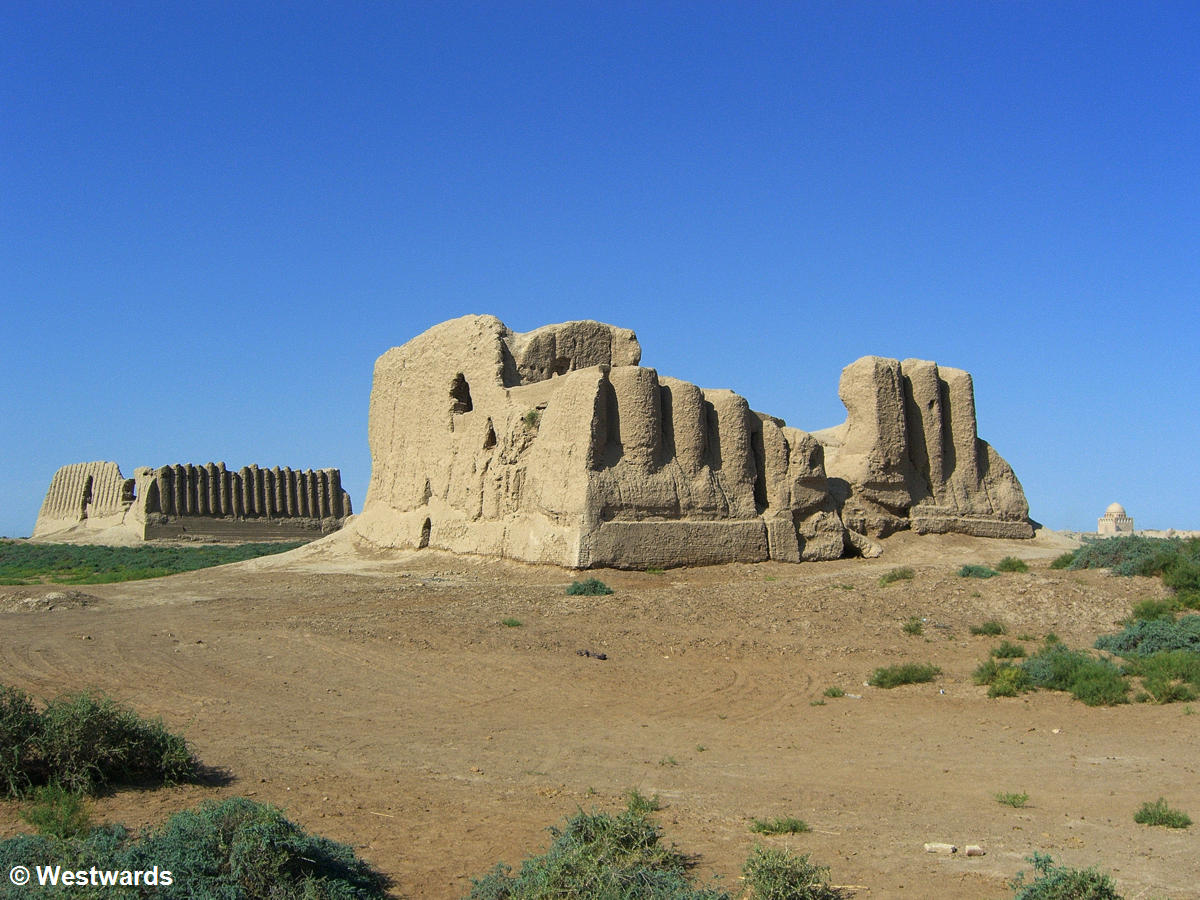
The region of ancient Merv was one of the earliest centres of agriculture. Several consecutive cities, from Bronze age to Middle ages, are preserved in the desert. It’s an archaeologist’s dream and for individual travellers one of the most exciting places you could visit.
When we enter the museum in the town of Mary (the modern city near the ancient Merv), a whole platoon of soldiers is waiting in the archaeological section for a guided tour. “Too many men in that room”, the cashier tells us and advises to start with the ethnographic exhibition instead, which turns out to be quite interesting, too.
In the archaeological hall, we then opt for a guided tour as the written explanations are extremely scarce. The guide shows us Zoroastrian cult objects and priests’ sceptres. The Zoroastrian priests used to drink some intoxicating liquid with a kind of straw in their ceremonies. They had decorated stands specifically to put the straw. And of course, the museum also houses a number of stones and decorative elements from the ancient city of Merv.
Many centuries of civilisation
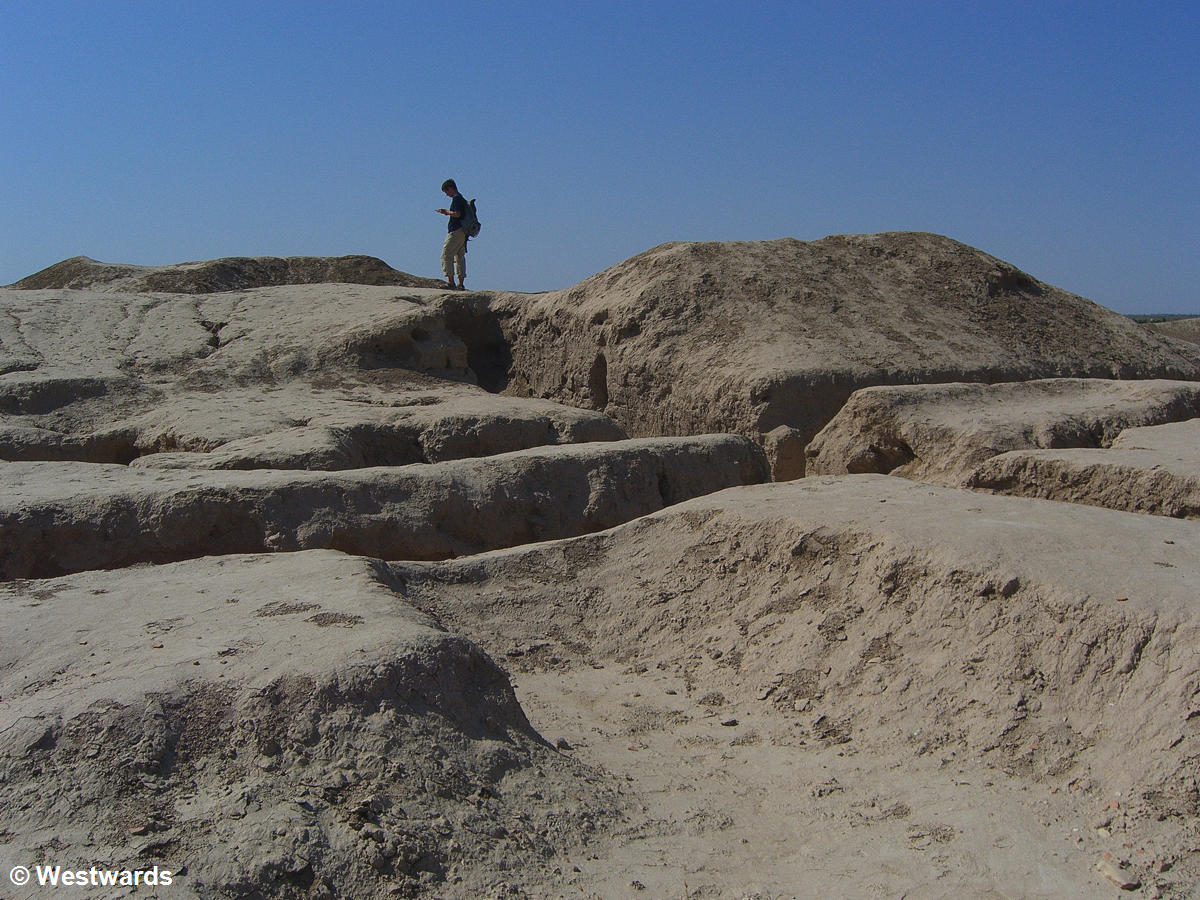
Merv is the oldest of the oasis cities on the Central Asian Silk Road, dating back as far as the 3rd millennium BC. The Bactria-Margiana region in today’s Turkmenistan, Uzbekistan, and Afghanistan, was one of the earliest centres of agriculture and sedentary life. The first Neolithic settlements appeared here nearly 8000 years ago, and Bronze Age culture thrived from about 2400 BC.
The archaeological site of Merv consists of several separate settlements from the Bronze Age onwards – the most important one being the mediaeval capital city of the Seljuks in the 11th to 12th century.
In the city’s heyday, this must have been a pleasant oasis watered by a delta of the Murgab River. Today, however, Merv is a desert area with archaeological excavations and a few ruins and restored buildings looming over the sand.
How to go sightseeing in a deserted place
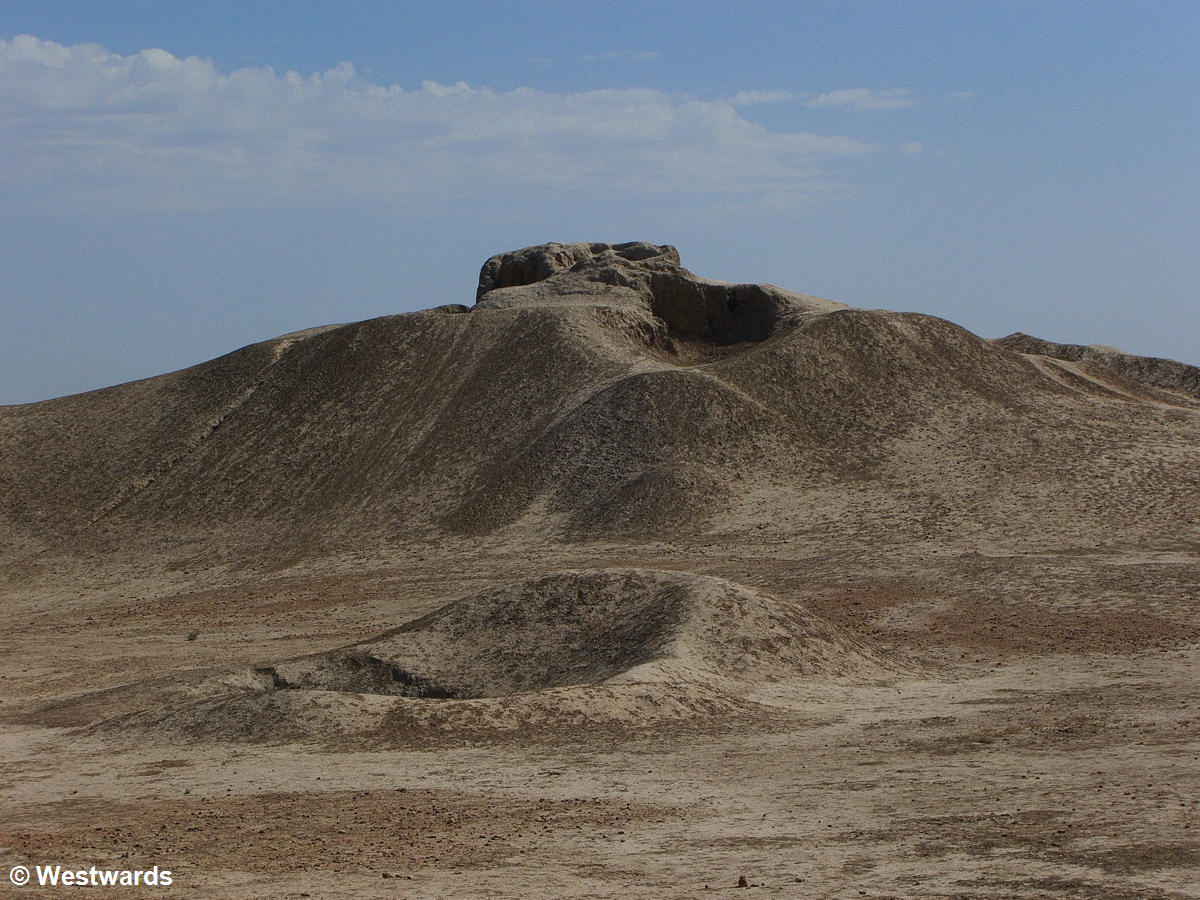
As the information given in our guidebook is (again) not very comprehensive, we are looking for a guide to visit the archaeological area. We are approached by a man who offers us a tour and dwells lengthily on his knowledge of the history and the place. But some sceptical questioning quickly reveals that he neither knows anything about history nor does he speak much English.
The museum staff advise us to hire a guide directly at the excavation site. Yet, while we do find a taxi driver to bring us there – Mohammed, who doesn’t speak English and knows nothing about history either but offers his services at a very fair rate (2 USD per hour) –, we find no guide, or even explanatory panels in ancient Merv. We are lucky to be able to buy a small but quite detailed booklet about the city’s archaeological remains, written by one of the archaeologists working there, and proceed to explore the remains chronologically.
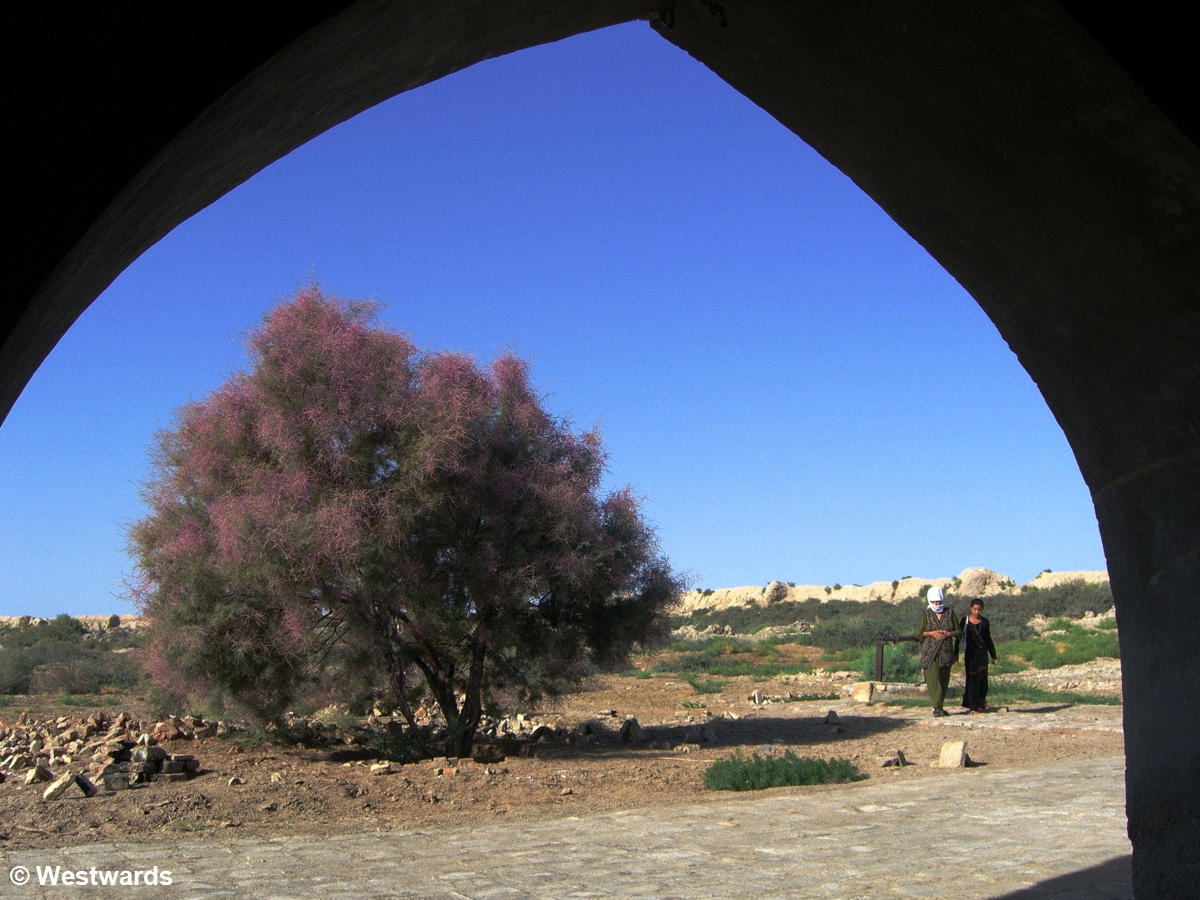
Conveniently for the archaeologists, the rulers of each epoch started to build a new city right next to the old one, so that the researchers today don’t have to decide which period they are going to destroy in order to dig out another one. Each of the cities is surrounded by high walls. Those of big and small Kyz Kala, fortresses from the early Arabic period, still stand high and impressive, with defensive battlements and crenels.
Walk to work in ancient Merv
The oldest city was Erk Kala, built in the Achaemenid period (6th–3rd century BC). Its mud brick walls are worn down to broad ramparts, but are still clearly visible. Given the period, Merv had to be a “walk to work” city, as our booklet describes it. The city area is about 2 km square, just small enough to navigate on foot.

The whole archaeological site, however, is quite big. We are glad to have the car to bring us to the enormous Sultan Sanjar Mausoleum, the 27 m high tomb of the most important Seljuk ruler who died in 1157. It is one of the main attractions, recently restored and partly reconstructed by Turkish archaeologists.
Finally, we follow the guidebook to hunt down some minor attractions, such as the Mohammed ibn-Zeid Mausoleum. Mohammed, the driver, doesn’t know these places although he grew up in the area, but eagerly takes note of the names – it may come useful for future tourists. Although, admittedly, individual tourists were (when we visited in 2006) and are still a rarity in Turkmenistan. The only type of visa allowing tourists to visit individually is a transit visa.
The State and Cultural Park “Ancient Merv” became a UNESCO Heritage Site in 1999. It is the oldest and most completely preserved one of the oasis cities along the Silk Roads in Central Asia. Other archaeological sites of Silk Road towns we have visited were much smaller or less impressive. For instance, we have walked through the desert to Akyrtas in Kazakhstan and to Paikent in Uzbekistan.
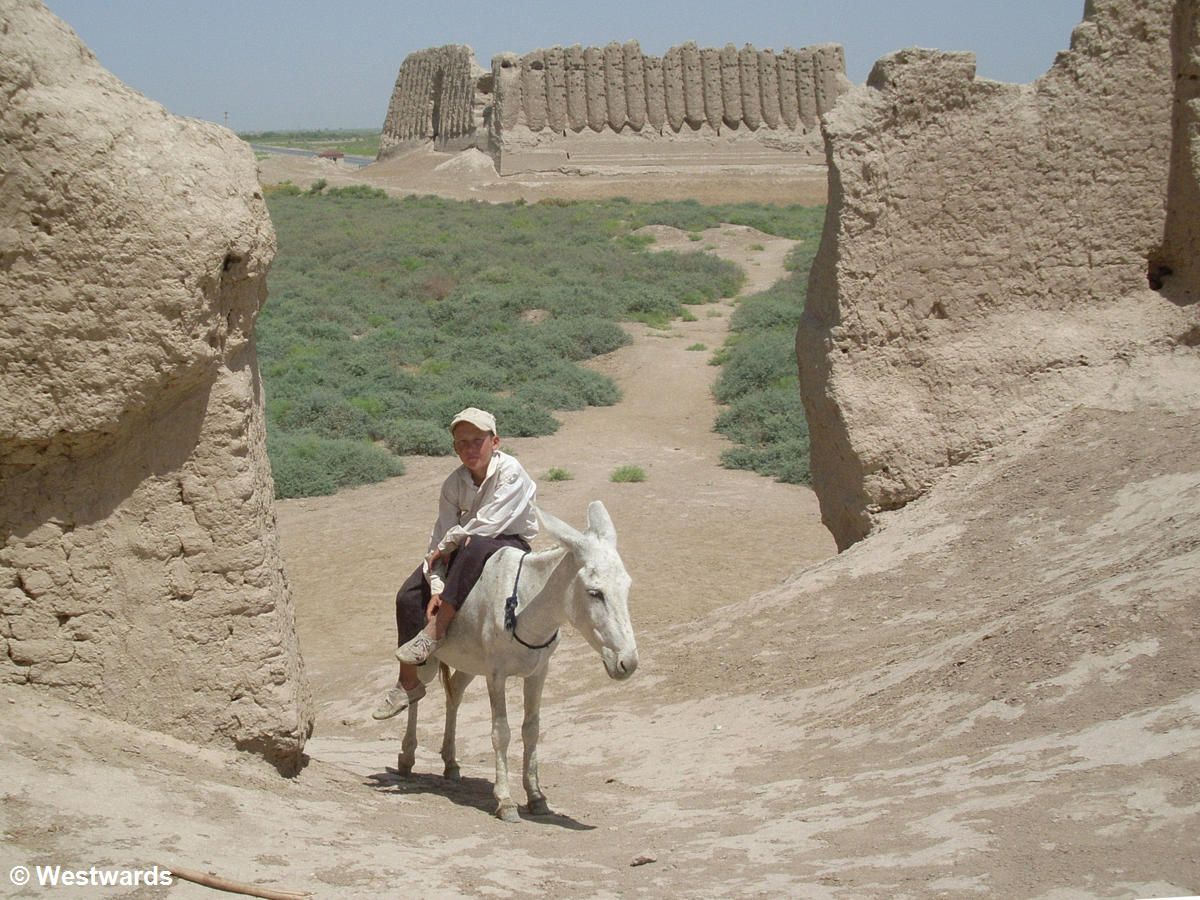
Is it worth visiting ancient Merv?
Turkmenistan is one of the least visited countries in the world, although it has a rich and varied history. The main difficulty is obtaining a visa. We have several times travelled through Turkmenistan on a transit visa. The ancient town of Merv is quite spread out. In order to get out most of the ruins you need a good guidebook, non-fiction book or a knowledgeable guide. With this, it’s a very impressive and fascinating place.
How to get to ancient Merv?
Merv is situated about 30 km from Mary. As there is no public transport, you need to hire a taxi to bring you there and drive you around if you aren’t on an organised tour. We paid 2 USD per hour for a Russian speaking driver (this was back in 2006).
Want to visit with Natascha as a guide?
Check our planned tours as tour guides at “Reiseleitungen” for Silk Road tours that include Turkmenistan.
NB: Our travels to Old Nisa was not sponsored in any way. We paid all travel expenses ourselves.
Never miss a new post! Get notifications about new posts straight into your inbox!




I’ve never heard of Merv, thank you for introducing me to someplace new. I can understand why the Park has designated a UNESCO Heritage Site in 1999 to protect that fascinating history.
Seriously sounds like a fascinating place to visit. Turkmenistan is understandably not high on my list but I do love exploring historic sites wherever we go. Merv reminds me a little of Ostia Antica near Rome.
It’s hard to even fathom the ancient timeline of Merv, and how the landscape has changed so drastically! One has to wonder if climate change is a natural course of nature (but of course, let’s take steps to prevent hastening it). You must have felt like real explorers uncovering the past without a tour guide!
Dear Jackie, we had read about the area and the history and city of Merv before. But still, it was quite exciting!
Never heard of Merv, but being a history and architecture buff, I am sold! Thank you for showing this archaeological gem. Loved the intricate work of the Sultan Sanjar Mausoleum and the landscapes of Merv. Literally transported me to that era!
Wow I would love to go see this- my husband and I love visiting UNESCO sites. I’m like you, I would have wanted to hire a guide- but at least you were able to pick up a book with information.
I’m interested in learning more about ancient Merv’s as well as its history. I’d also want to attempt sightseeing in a deserted location because it’s something new for me. Sultan Sanjar Mausoleum grabbed my attention because of its distinctive architectural form, and I’m delighted this has already been restored and refurbished. You still had a terrific tour despite not being able to hire a guide. Thumbs up!
Dear Maria, we had a good time and it was very interesting.
Lovely blog. Goes to show that life was flushing way before Christ and to actually be there in the archaeological sites must be amazing. I can understand how Turkmenistan is one of the least visited country’s in the world as 90% of people would have never heard of it. And same goes for Merv. So thank you for given us this blog to help educate people.
I learned so much about the Silk Road from your posts. From the never heard before cities to ancient city like Merv. But it sounds like Turkmenistan doesn’t really want tourists to come to their country. One of the least visited countries in the world and yet, it’s hard to obtain the visa.
Dear Umiko, you are right. Turkmenistan does not really want tourists. They make it quite difficult to get a visa – but it is a beautiful and at the same tame quite weired country with friendly people.
I saw a short clip on tv about the UNESCO area of Merv a while ago but couldn’t remember where it was until I saw your post (thank you). I love that it has been preserved and that there is so much of it compared to some of the smaller locations you have been to. It just shows the positive impact of promoting in a manner that doesn’t allow for high traffic. I would love to visit and see for myself and walk the 2km route.